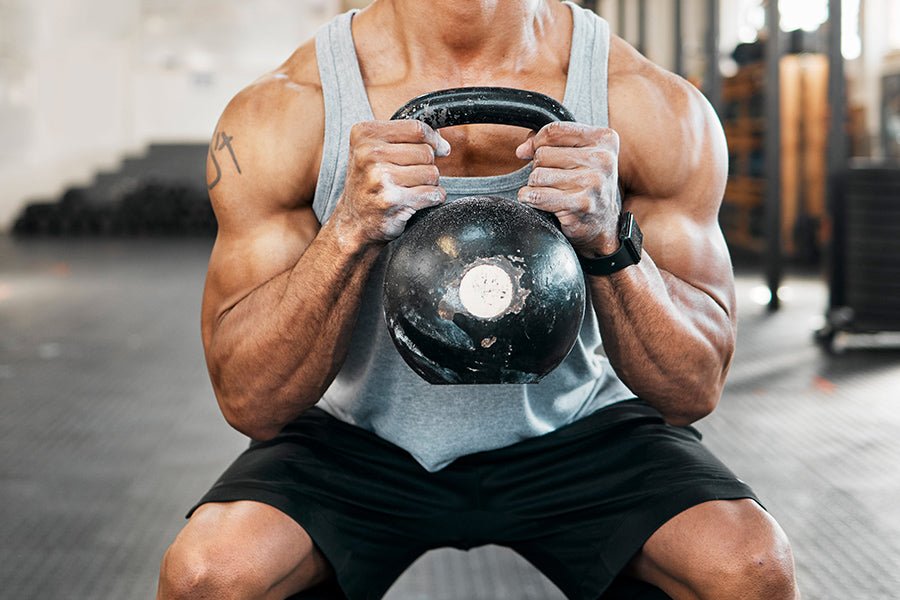To the untrained eye, the Cossack squat may look like a sloppy squat or even a cheat squat. It couldn't be further from the truth! The Cossack squat is a great way to add variety to your lower body workouts, and it comes with several additional benefits over a traditional squat.
The cossack squat strengthens the lower back and abdominals in addition to the thighs, buttocks, and hip adductors. This includes the joints and connective tissues in your hips, knees, and ankles.
There may be some initial difficulty learning this move, but it's well worth the effort. In its most basic form, a Cossack squat consists of performing a deep squat with one leg while performing half of a split on the other.
The hamstrings and adductors in the leg that is not used to squat are put through a significant amount of stretching, while the leg that is used to squat is challenged by reaching full flexion at the hip, knee, and ankle.
While performing the bilateral equivalent of the deep squat or splits, each leg supports the other through a range of motion that it may not be able to achieve on its own. This article covers the correct way to perform the cossack squats, their benefits, and the muscles worked.
How to Do Cossack Squat - Step By Step
The Cossack Squat is comparable to a standard squat, except that, instead of putting equal emphasis on both legs during the exercise, you shift your body weight, so it is concentrated more heavily on one leg.
To ensure that you are performing the Cossack Squat in the correct form, follow these instructions:
- Stand up with your feet farther apart than your shoulders. The toes should either point straight forward or slightly outwards.
- To do a squat, shift your weight onto one foot and continue to squat until your hip is lower than your knee.
- While keeping the opposite leg completely straight, the other leg should be bent.
- At all times, the chest needs to be held straight, and the hips must be maintained down.
- Utilizing the strength of your bent leg, extend your body returning to the starting position.
- Repeat this motion on the other side, shifting your weight on your other leg this time.
- Starting with three sets of ten to twenty reps of the Cossack Squat is a decent workout (5 to 10 on each leg).
Related Article: Goblet Squat: How to Do, Variations and Common Mistakes
Muscles Worked
Cossack squats work the hamstrings and adductors via eccentric loading while also strengthening the knee and hip extensors of the squatting leg. The primary muscle groups that the Cossack squat engages in are summarized here.
Adductors
The adductors are trained eccentrically during the descending portion of the Cossack squat. Exercising the adductors with the Cossack squat is a great way to improve their mechanical strength, muscle fascicle length, and flexibility.
It's common for people to have weak adductors despite the importance of these muscles. Incorporating the Cossack squat into your routine is beneficial because of the work it does to strengthen the adductors.
Hamstrings
At the same time as the adductors are being strengthened, the hamstrings are also being extended during the descending part of the exercise. When you rotate your foot on the straight leg, you switch the stretch from focusing on the adductor to the hamstring. The hamstring stretch increases proportionally with the amount of foot inclination.
Quadriceps
The knee extensors, often known as the quadriceps, are in an extended posture when doing the Cossack squat because the squatting leg has a deep knee bend. As a result, the quadriceps are the ones that have to put in the effort to lift you out of the deep squat while you are simultaneously pressing down into the ground to go back to the beginning position.
Glutes
At the bottom position of the deep squat, when the hip is in an extended posture, the glutes exert force to stretch the hip.
Benefits of the Cossack Squat
The Cossack squat is often misunderstood as a simple bodyweight or flexibility practice. Strengthening your Cossack squat improves your frontal plane mobility and neuromuscular control.
Don't be shocked if it increases your lower body eccentric strength and decreases your asymmetry, allowing you to squat and deadlift more weight.
Restores or Improves Your Range of Motion
The Cossack squat stretches the hamstrings and adductors, stretching the hips, knees, and ankles. Squatting injuries, such as hamstring and groin pulls, are more likely to occur in those with poor range of motion. The performance benefits of increased lower-body mobility may be unlocked by regularly performing Cossack squats.
Builds Resilient Joints & Soft Tissues
Cossack squatting to full depth can improve joint and soft tissue health and resiliency. The straight leg in a Cossack squat stretches the hamstrings and adductors to a great extent, while the bent leg achieves full depth at the ankle, knee, and hip.
Joint health is improved, and soft tissue injuries like groin and hamstring pulls are prevented when these postures can be entered and exited with precision and ease.
Improves Frontal Plane Movement Ability
The human body can move in three planes: the sagittal, the frontal, and the transverse. You'll find yourself doing most of your typical strength training routines in the sagittal plane. However, the risk of injury increases and performance potential is not maximized if frontal plane movement is ignored.
Therefore, athletes and the general public would benefit from developing strength and agility in the frontal plane.
Better Squats
Working on your Cossack squats can help you reach your squat depth goals. When at the bottom position of a Cossack squat, your knees, hips, and ankles will all be bent further than they need for a standard squat.
Single-leg exercises also improve strength and range of motion and prevent injury by balancing the body's asymmetries between the right and left sides.
Variations
Try these variations on a cossack squat if you need assistance or more of a challenge.
Gymnastic Rings Cossack Squat

If you cannot finish a cossack squat with your present level of strength or mobility, you should begin with a variant that uses gymnastic rings for assistance. You will be able to achieve your maximum potential with the assistance of the gymnastic rings.
- Hold the handles of the gymnastic rings while extending your arms and doing the cossack squat action.
- The gymnastic rings should be adjusted to a medium length, so it isn’t too long or too short.
Front Rack Cossack Squat

If you have difficulty keeping your torso upright, you may benefit from using some counterweight in the shape of one or two kettlebells, as maintaining your upright position will become less difficult.
- Start in a normal cossack squat position while holding a dumbbell, kettlebell, or bumper plate with both hands.
- While lowering yourself, keep both hands on them and hold them in front of your chest.
- Complete the movement like you will normally do for a cossack squat.
Single Arm Cossack Squat to Press

Here is how a single arm cossack squat to press is performed:
- Hold a light dumbbell or kettlebell in your hand opposite to the leg you squat on.
- As you move down to a squat, raise the arm carrying the weight straight up
- As you ascend back to starting position, move your arm back to the starting position as well
- Finish your reps on this side, switch the weight to the other hand and complete the reps on the other side.
Mistakes to Avoid
Individuals make four typical mistakes, all of which should be brought to your attention so you can steer clear of them.
Leaning Too Forward
During the Cossack Squat, be sure that your chest is always held in an upright position. During the exercise, it should feel like you are sitting back on your glutes rather than standing up. You should keep your weight on your back during the whole action.
Moving Too Quickly
This is not a race to see who can do the Cossack Squat in the quickest amount of time. If you perform too rapidly, your form will suffer, which increases the risk of damage. You won't get the full advantages of the workout unless you do it slowly.
Back Arched
If you are leaning forward, there is a good likelihood that your back is rounded as well. During the Cossack Squat, if you do not keep your torso straight, you will exert additional stress on your spine, which is counterproductive to the exercise's goal of strengthening the spine.
Heels Coming Off of the Floor
During the exercise, you should ensure that the foot of the leg that is bent is firmly placed on the ground. If your heel lifts off the ground as you move, it is likely because you have some flexibility issues. In this scenario, you should lower your body as much as possible without raising your heel off the floor and do exercises that improve ankle mobility.
Related Article: 15 Common Squat Form Mistakes You Need to Avoid
Take Away
The cossack squat is an exciting method to test your mobility and muscular strength. Your body will benefit from a greater range of motion if you include them in your leg day routine, either as a warmup or as an adjunct to weighted leg motions. Add additional weight to make this a challenging strength training exercise.











